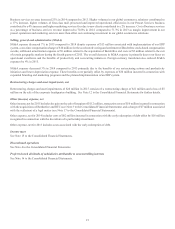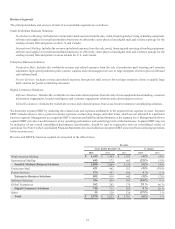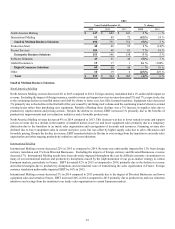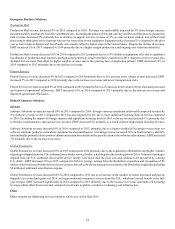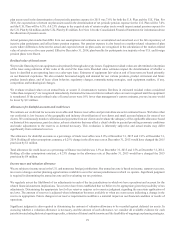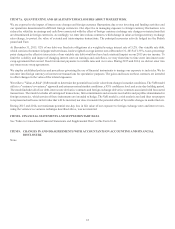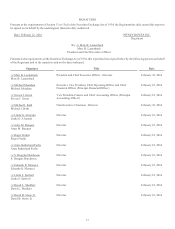Pitney Bowes 2015 Annual Report Download - page 46
Download and view the complete annual report
Please find page 46 of the 2015 Pitney Bowes annual report below. You can navigate through the pages in the report by either clicking on the pages listed below, or by using the keyword search tool below to find specific information within the annual report.30
If new information becomes available that would alter our estimate of the amount of deferred tax assets that will ultimately be realized,
we adjust the valuation allowance with a corresponding impact to income tax expense in the period in which such determination is made.
Impairment review
Long-lived and finite-lived intangible assets are reviewed for impairment whenever events or changes in circumstances indicate that the
carrying amount may not be fully recoverable. The estimated future undiscounted cash flows expected to result from the use and eventual
disposition of the assets is compared to the carrying value. We derive the cash flow estimates from our long-term business plans and
historical experience. If the sum of the undiscounted cash flows is less than the asset's carrying value, an impairment charge is recorded
for an amount by which the carrying value exceeds its fair value. The fair value of the impaired asset is determined using probability
weighted expected cash flow estimates, quoted market prices when available and appraisals, as appropriate. Changes in the estimates
and assumptions incorporated in our impairment assessment could materially affect the determination of fair value and the associated
impairment charge.
Goodwill is tested annually for impairment at the reporting unit level during the fourth quarter or sooner when circumstances indicate
an impairment may exist. The impairment test for goodwill is a two-step approach. In the first step, the fair value of each reporting unit
is determined and compared to the reporting unit's carrying value, including goodwill. If the fair value of a reporting unit is less than its
carrying value, the second step of the goodwill impairment test is performed to measure the amount of impairment, if any. In the second
step, the fair value of the reporting unit is allocated to the assets and liabilities of the reporting unit as if it had been acquired in a business
combination and the purchase price was equivalent to the fair value of the reporting unit. The excess of the fair value of the reporting
unit over the amounts assigned to its assets and liabilities is referred to as the implied fair value of goodwill. The implied fair value of
the reporting unit's goodwill is then compared to the actual carrying value of goodwill. If the implied fair value of goodwill is less than
the carrying value of goodwill, an impairment loss is recognized for the difference.
Significant estimates and assumptions are used in our goodwill impairment review and include the identification of reporting units,
assigning assets and liabilities to reporting units, assigning goodwill to reporting units and determining the fair value of each reporting
unit. The fair value of each reporting unit is determined based on a combination of techniques, including the present value of future cash
flows, multiples of competitors and multiples from sales of like businesses. The assumptions used to estimate fair value are based on
projections incorporated in our current operating plans as well as other available information. Our operating plans include significant
assumptions and estimates associated with sales growth, profitability and related cash flows, along with cash flows associated with taxes
and capital spending. The determination of fair value also incorporates a risk-adjusted discount rate based on current interest rates and
the economic conditions of the reporting unit. We also consider other assumptions that market participants may use. Changes in any of
these estimates or assumptions could materially affect the determination of fair value and the associated goodwill impairment charge for
each reporting unit. Potential events and circumstances, such as the inability to acquire new clients, downward pressures on pricing and
rising interest rates could have an adverse impact on our assumptions and result in non-cash impairment charges in future periods.
Based on the results of the annual impairment test performed during the fourth quarter of 2015, we determined that the estimated fair
value of each of the reporting units exceeded their carrying value by more than 20%.
Stock-based compensation expense
We recognize compensation cost for stock-based awards based on the estimated fair value of the award, net of estimated forfeitures.
Compensation costs for those shares expected to vest are recognized on a straight-line basis over the requisite service period.
The fair value of stock awards is estimated using a Black-Scholes valuation model or Monte Carlo simulation model. These models
require assumptions to be made regarding the expected stock price volatility, risk-free interest rate, life of the award and dividend yield.
The expected stock price volatility is based on historical price changes of our stock. The risk-free interest rate is based on U.S. Treasuries
with a term equal to the expected life of the stock award. The expected life of the award and dividend yield are based on historical
experience.
We believe that the valuation techniques and the underlying assumptions are appropriate in estimating the fair value of our stock-based
awards. If factors change causing our assumptions to change, our stock-based compensation expense could be different in the future.
Estimates of fair value are not intended to predict actual future events or the value ultimately realized by employees who receive equity
awards, and subsequent events are not indicative of the reasonableness of the original estimates of fair value. In addition, we are required
to estimate the expected forfeiture rate and recognize expense only for those shares expected to vest. If our actual forfeiture rate is
materially different from our estimate, stock-based compensation expense could be significantly different from what we have recorded
in the current period.



